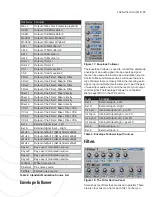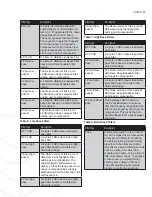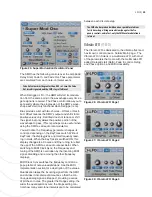
CEM OSCILLATORS (CEM) |
13
CEM Oscillators
(CEM)
Figure 9: CEM Oscillator Pair
The CEM oscillators are the same as in my Prophet
Plus and Pro One emulations, however, because of
major differences in the signal chain design of Solaris,
the output of this oscillator pair is much ‘quieter’ than
the other oscillator choices. This is because the CEM
oscillator is actually an optimized block that produces 6
simultaneous waveshapes, and therefore, divides the
dynamic range to avoid clipping if the maximum mix
levels for all 6 waveshapes were applied. To compen-
sate somewhat for this, I have added boost controls
after each
fi
lter, as well as an override to switch off the
Pan circuit (which reduces the gain as an averaged
signal as well). It comes out to be about 22 dB less for
each CEM output, which is considerably less than the
MM Oscs, for example. Even using the boost, you will
sometimes
fi
nd an overloaded or saturated (extremely
‘clipped’ or distorted) sound when trying to increase the
level for these oscillators, so please be mindful of this
affect.
Each Boost starts at a displayed value of 2.5 dB. This
matched the signal level when the
fi
lter was bypassed,
so I set it as a minimum setting for the Boost.
Modular Oscillators
( Modular)
Figure 10: Modular Oscillator Pair
These special purpose Modular Windows allow the
ultimate customization of the sound sources. To use,
fi
rst Enable the desired section with the blue buttons,
then open the appropriate Modular Window by clicking
on the Show button. You can then drag in the desired
Modular modules as needed. (Each Window has a text
fi
eld labeling it as ‘Mod1 Slot’ or ‘Mod2 Slot’.)
Figure 11: Modular Window
Input
Description
Freq
Frequency control. This includes the Coarse
and Fine tuning, and any Frequency Modu-
lation assigned from the front panel section.
Shape Waveshape control. This receives the Initial
control amount and two modulation sources
for Shape Mod from the front panel section.
Note
This is a numeric value called Note gener-
ally used to control key tracking modules.
For oscillators it would be used with the
Wav Osc module.
Sync
This provides a signal from Multimode Osc
2 as a master sync tone for hard sync'ing
Modular oscillators. The Coarse and Fine
settings of MM Osc 2 are used to set the
fundamental frequency.
Table 5: Modular Inputs
Input
Description
MIDI
This is a direct input from the MIDI IN of
the Solaris
Shape
Waveshape control. This receives the
Initial control amount and two modula-
tion sources for Shape Mod from the front
panel section.
Gate
This is a direct Gate signal from the Solaris'
Midi Voice Control
Table 6: Gate & MIDI In
Audio Out
The
fi
nal result of the Modular patch is fed to the Audio
Out, which then can be routed to the mixers as Modular
1 or 2. See Saving Modular Patches for instructions on
saving your work.














































